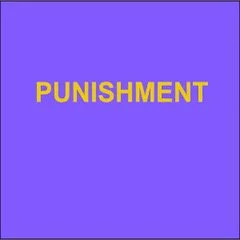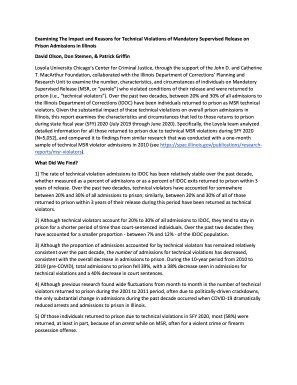Examining The Impact and Reasons for Technical Violations of Mandatory Supervised Release on Prison Admissions in Illinois
By David Olson, Don Stemen, & Patrick Griffin
Loyola University Chicago’s Center for Criminal Justice, through the support of the John D. and Catherine T. MacArthur Foundation, collaborated with the Illinois Department of Corrections’ Planning and Research Unit to examine the number, characteristics, and circumstances of individuals on Mandatory Supervised Release (MSR, or “parole”) who violated conditions of their release and were returned to prison (i.e., “technical violators”). Over the past two decades, between 20% and 30% of all admissions to the Illinois Department of Corrections (IDOC) have been individuals returned to prison as MSR technical violators. Given the substantial impact of these technical violations on overall prison admissions in Illinois, this report examines the characteristics and circumstances that led to those returns to prison during state fiscal year (SFY) 2020 (July 2019 through June 2020). Specifically, the Loyola team analyzed detailed information for all those returned to prison due to technical MSR violations during SFY 2020 (N=5,052), and compared it to findings from similar research that was conducted with a one-month sample of technical MSR violator admissions in 2010 (see https://spac.illinois.gov/publications/researchreports/msr-violators). What Did We Find? 1) The rate of technical violation admissions to IDOC has been relatively stable over the past decade, whether measured as a percent of admissions or as a percent of IDOC exits returned to prison within 3 years of release. Over the past two decades, technical violators have accounted for somewhere between 20% and 30% of all admissions to prison; similarly, between 20% and 30% of all of those returned to prison within 3 years of their release during this period have been returned as technical violators. 2) Although technical violators account for 20% to 30% of all admissions to IDOC, they tend to stay in prison for a shorter period of time than court-sentenced individuals. Over the past two decades they have accounted for a smaller proportion - between 7% and 12% - of the IDOC population. 3) Although the proportion of admissions accounted for by technical violators has remained relatively consistent over the past decade, the number of admissions for technical violations has decreased, consistent with the overall decrease in admissions to prison. During the 10-year period from 2010 to 2019 (pre-COVID), total admissions to prison fell 39%, with a 38% decrease seen in admissions for technical violations and a 40% decrease in court sentences. 4) Although previous research found wide fluctuations from month to month in the number of technical violators returned to prison during the 2001 to 2011 period, often due to politically-driven crackdowns, the only substantial change in admissions during the past decade occurred when COVID-19 dramatically reduced arrests and admissions to prison in Illinois. 5) Of those individuals returned to prison due to technical violations in SFY 2020, most (58%) were returned, at least in part, because of an arrest while on MSR, often for a violent crime or firearm possession offense. 6) One out of every 5 people (20%) “returned” to prison for technical violations in SFY 2020 did not have an approved place to live, and so were not in fact released at all (referred to as “gate violators” by IDOC). Most (84%) of those returned as gate violators had been serving prison sentences for sex offenses, a population that historically has challenges finding approved housing upon release from prison. 7) COVID-19 dramatically reduced the number of admissions to IDOC for technical violations and resulted in a shift in the nature of technical violations that resulted in admission to prison. While the percent of prison admissions accounted for by technical violations did not change between SFY 2011 and the portion of SFY 2020 that preceded the beginning of the COVID-19 pandemic, a smaller portion of those admitted in the pre-COVID part of SFY 2020 were for non-arrest violations and a larger share of admissions involved new arrest charge(s), particularly for violent and firearm possession offenses.
Loyola Chicago Center for Criminal Justice, 2023. 11p.


